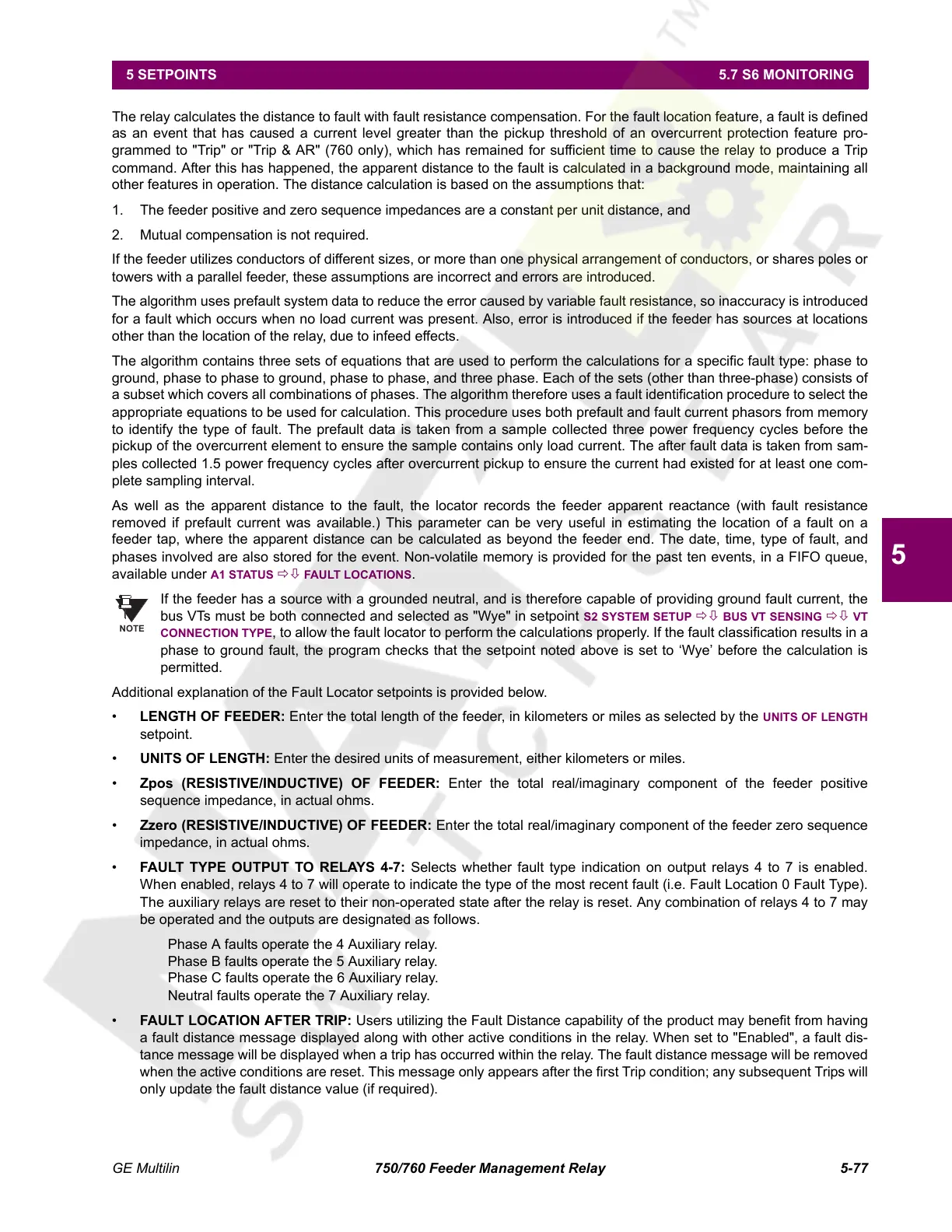GE Multilin 750/760 Feeder Management Relay 5-77
5 SETPOINTS 5.7 S6 MONITORING
5
The relay calculates the distance to fault with fault resistance compensation. For the fault location feature, a fault is defined
as an event that has caused a current level greater than the pickup threshold of an overcurrent protection feature pro-
grammed to "Trip" or "Trip & AR" (760 only), which has remained for sufficient time to cause the relay to produce a Trip
command. After this has happened, the apparent distance to the fault is calculated in a background mode, maintaining all
other features in operation. The distance calculation is based on the assumptions that:
1. The feeder positive and zero sequence impedances are a constant per unit distance, and
2. Mutual compensation is not required.
If the feeder utilizes conductors of different sizes, or more than one physical arrangement of conductors, or shares poles or
towers with a parallel feeder, these assumptions are incorrect and errors are introduced.
The algorithm uses prefault system data to reduce the error caused by variable fault resistance, so inaccuracy is introduced
for a fault which occurs when no load current was present. Also, error is introduced if the feeder has sources at locations
other than the location of the relay, due to infeed effects.
The algorithm contains three sets of equations that are used to perform the calculations for a specific fault type: phase to
ground, phase to phase to ground, phase to phase, and three phase. Each of the sets (other than three-phase) consists of
a subset which covers all combinations of phases. The algorithm therefore uses a fault identification procedure to select the
appropriate equations to be used for calculation. This procedure uses both prefault and fault current phasors from memory
to identify the type of fault. The prefault data is taken from a sample collected three power frequency cycles before the
pickup of the overcurrent element to ensure the sample contains only load current. The after fault data is taken from sam-
ples collected 1.5 power frequency cycles after overcurrent pickup to ensure the current had existed for at least one com-
plete sampling interval.
As well as the apparent distance to the fault, the locator records the feeder apparent reactance (with fault resistance
removed if prefault current was available.) This parameter can be very useful in estimating the location of a fault on a
feeder tap, where the apparent distance can be calculated as beyond the feeder end. The date, time, type of fault, and
phases involved are also stored for the event. Non-volatile memory is provided for the past ten events, in a FIFO queue,
available under
A1 STATUS ÖØ FAULT LOCATIONS.
If the feeder has a source with a grounded neutral, and is therefore capable of providing ground fault current, the
bus VTs must be both connected and selected as "Wye" in setpoint S2 SYSTEM SETUP ÖØ BUS VT SENSING ÖØ VT
CONNECTION TYPE, to allow the fault locator to perform the calculations properly. If the fault classification results in a
phase to ground fault, the program checks that the setpoint noted above is set to ‘Wye’ before the calculation is
permitted.
Additional explanation of the Fault Locator setpoints is provided below.
• LENGTH OF FEEDER: Enter the total length of the feeder, in kilometers or miles as selected by the UNITS OF LENGTH
setpoint.
• UNITS OF LENGTH: Enter the desired units of measurement, either kilometers or miles.
• Zpos (RESISTIVE/INDUCTIVE) OF FEEDER: Enter the total real/imaginary component of the feeder positive
sequence impedance, in actual ohms.
• Zzero (RESISTIVE/INDUCTIVE) OF FEEDER: Enter the total real/imaginary component of the feeder zero sequence
impedance, in actual ohms.
• FAULT TYPE OUTPUT TO RELAYS 4-7: Selects whether fault type indication on output relays 4 to 7 is enabled.
When enabled, relays 4 to 7 will operate to indicate the type of the most recent fault (i.e. Fault Location 0 Fault Type).
The auxiliary relays are reset to their non-operated state after the relay is reset. Any combination of relays 4 to 7 may
be operated and the outputs are designated as follows.
Phase A faults operate the 4 Auxiliary relay.
Phase B faults operate the 5 Auxiliary relay.
Phase C faults operate the 6 Auxiliary relay.
Neutral faults operate the 7 Auxiliary relay.
• FAULT LOCATION AFTER TRIP: Users utilizing the Fault Distance capability of the product may benefit from having
a fault distance message displayed along with other active conditions in the relay. When set to "Enabled", a fault dis-
tance message will be displayed when a trip has occurred within the relay. The fault distance message will be removed
when the active conditions are reset. This message only appears after the first Trip condition; any subsequent Trips will
only update the fault distance value (if required).
NOTE
Courtesy of NationalSwitchgear.com

